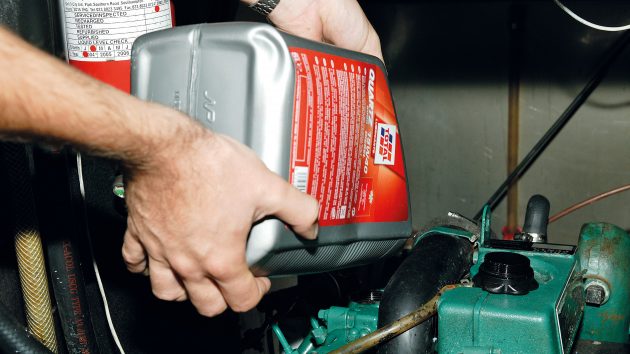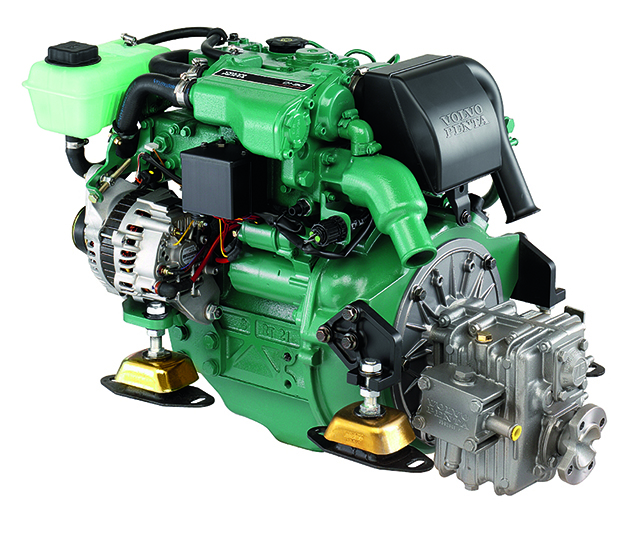Lubricating engine oil reduces wear and tear while neutralising corrosion, but ‘wears out’ faster with light and infrequent engine use
Lubricating oil in a marine diesel engine fulfils several functions. Whilst lubricating the working parts of the engine in order to reduce friction and wear, it also cools the parts of the engine that can’t be reached by the water-cooling system. Meanwhile, additives within the oil also reduce the effects of corrosion caused by the by-products of the combustion process.
Lubrication
The oil needs to be ‘sticky’ enough to cling to the engine parts requiring lubrication when the engine isn’t actually running, so that, when the engine starts up, there is already some protection in place before the circulating oil reaches those spots.
The oil also needs to be ‘thin’ enough when it’s cold, so that it will flow easily and not create too high a pressure, yet ‘thick’ enough when it’s hot, so that it will still flow easily without allowing the pressure to fall to too low a value.
Article continues below…
How it works: Diesel Engine Air System
Every sailor needs to understand how their diesel engine works. In the second of this series, we look at the…
How it works: The diesel engine: The 4-stroke cycle
Understanding how your diesel engine works is key to knowing how to look after it, and fix it when it…
Cooling
The oil is sprayed onto surfaces of components that need to be cooled, such as the inside of the hollow piston, to take away the heat of combustion. Because combustion temperatures can reach close to 1,000°C, the inside of the piston becomes very hot, as does the cylinder wall, so the oil must not lose its lubricating properties under these conditions. The conditions become even more severe when required to cool a turbo-charger.
Corrosion
A by-product of combustion is sulphurous acid. At normal engine running temperatures this is volatile, but most of it will ‘boil off’ before it can contaminate the lubricating oil.
If the sulphurous acid doesn’t reach sufficient temperature, or cools, it becomes sulphuric acid which can then contaminate the oil, leading to significant corrosion. Good lubricating oil will contain corrosion inhibitors which will be used up in doing their job. The cooler the engine is run, the more quickly these inhibitors will be exhausted. Light or infrequent engine use will require the oil to be changed more frequently than specified in the engine manufacturer’s handbook.

Sump pump
Lubricating oil settles in the engine oil sump located at the bottom of the engine. This is the equivalent of the oil ‘tank’. An engine-driven oil pump sucks oil from the sump through a coarse strainer located in the sump. The oil, under pressure, is then delivered to the oil filter, after which it is distributed through pipes and oil galleries to all of the parts of the engine that require lubrication. The oil returns to the sump by dribbling back down the sides and working parts of the engine. When the engine is stopped, it takes some time for all of the oil to return back to the sump.
Oil changes
Never exceed the oil change intervals specified in the engine’s handbook. An annual oil change should be the minimum, even with low engine hours. The best time for an annual oil change is just before you lay the boat up for the winter, because then the new oil with its fresh anti-corrosion additives will be in place during the period that the boat is out of use. The oil filter is also normally changed at the same time as the oil.
Enjoyed reading this?
A subscription to Yachting Monthly magazine costs around 40% less than the cover price.
Print and digital editions are available through Magazines Direct – where you can also find the latest deals.
YM is packed with information to help you get the most from your time on the water.
-
-
- Take your seamanship to the next level with tips, advice and skills from our experts
- Impartial in-depth reviews of the latest yachts and equipment
- Cruising guides to help you reach those dream destinations
-
Follow us on Facebook, Twitter and Instagram.






